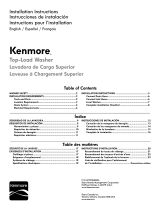
3
You will need:
n
A water heater set to 120° F (49° C).
n
A grounded electrical outlet located within 4 ft (1.2 m) of
power cord on back of washer.
n
Hot and cold water faucets located within 3 ft (0.9 m) of hot
and cold water ll valves on washer, and water pressure
of 20-100 psi (138-690 kPa).
n
A level oor with maximum slope of 1" (25 mm) under entire
washer. Installing on carpet is not recommended.
n
Floor must support washer’s total weight (with water and load)
of 315 lbs (143 kgs).
IMPORTANT: Do not install, store, or operate washer where it will
be exposed to weather or in temperatures below 32° F (0° C).
Water remaining in washer after use may cause damage in low
temperatures. See “Washer Care” in your Use and Care Guide
for winterizing information.
Proper installation is your responsibility.
Recessed area or closet installation
Dimensions show recommended spacing allowed, except for
closet door ventilation openings which are minimum required.
This washer has been tested for installation with spacing of
0" (0 mm) clearance on the sides. Consider allowing more space
for ease of installation and servicing, and spacing for companion
appliances and clearances for walls, doors, and oor moldings.
Add spacing of 1" (25 mm) on all sides of washer to reduce
noise transfer. If a closet door or louvered door is installed,
top and bottom air openings in door are required.
3"
(76 mm)
3"
(76 mm)
24 in.
2
(155 cm
2
)
48 in.
2
(310 cm
2
)
1"
(25 mm)
1"
(25 mm)
5"
(126 mm)
14" max.
(356 mm)
19"
(482 mm)
DRAIN SYSTEM
Drain system can be installed using a oor drain, wall standpipe,
oor standpipe, or laundry tub. Select method you need.
Minimum diameter for a standpipe drain: 2" (51 mm). Minimum
carry-away capacity: 17 gal. (64 L) per minute. Top of standpipe
must be at least 39" (990 mm) high; install no higher than
96" (2.44 m) from bottom of washer. If you must install higher
than 96" (2.44 m), you will need a sump pump system.
Wall standpipe drain system
Laundry tub drain system
Minimum capacity: 20 gal. (76 L). Top of laundry tub must be at
least 39" (990 mm) above oor; install no higher than 96" (2.44 m)
from bottom of washer.
IMPORTANT: To avoid siphoning, no more than 4.5" (114 mm)
of drain hose should be inside standpipe or below the top of
wash tub. Secure drain hose with cable tie.
Floor drain system
Floor drain system requires a Siphon Break Kit (Part Number
285834), 2 Connector Kits (Part Number 285835), and an
Extension Drain Hose (Part Number 285863) that may be
purchased separately. To order, please see toll-free phone
numbers in your Use and Care Guide. Minimum siphon break:
28" (710 mm) from bottom of washer. (Additional hoses may
be needed.)
Floor standpipe drain system
4.5"
(114 mm)
39"
(990 mm)
4.5"
(114 mm)
39"
(990 mm)
See requirements for oor standpipe drain system.








